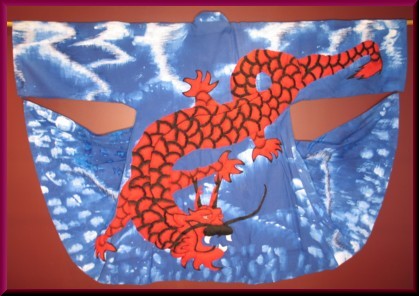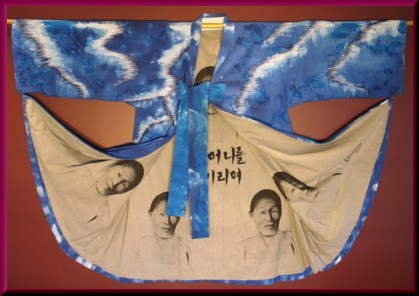
[ Back of The Robe ]

[ Front of The Robe ]
75" x 52"
Fabric dyed, silk-screened
and
freehand
machine
embroidered calico robe
|
IV.
"Ambivalence"
Background Story
The
Prince cried in his heart because the Japanese took thousands of young
Cho-Sun people (Korean). They used the men as soldiers on the frontier
of World War II. They used the women as 'entertainers' for
the
Japanese soldiers. These entertainers were girls and women
that
the soldiers repeatedly raped. This made the Prince very sad.
He was powerless to help them from the brutalities forced
upon
them. The Japanese had a rule which insisted that the royal
family should participate in their wars. Because of his
marriage
to the Princess, and hence his inclusion in the royal family, Prince
Lee Un was given the rank of commandant and forced to fight
on
the war frontier. The Prince contemplated his tragic
circumstances in silence. His country awaited liberation and
a
Japanese soldier, struck the Prince as a morbid irony. He
wanted
to scream to the world, "I am not a member of the Japanese royal
family. I am the crowned Cho-Sun Prince". His
painful
outcries remained suppressed in his heart. His position as
commandant was in name only, he actually had no power. He was
always being observed by the Japanese. Even today, it still
seems
incredulous that he remained silent, and did nothing to resist the
Japanese. Eventually, the Japanese lost the war.
Along with
the end of the Devil's outstretched hand. The suppression of
his
feelings during his regrettable past confused the Prince. He
screamed, "How can I go back to my young life as the Prince?
I'm
now old. What did I do for my own country?"
Description
This
robe shows the struggle of the Prince through the shape of the dragon.
The reduction of his power is represented by the use of black thread.
His head is now at the bottom of the robe, symbolizing his
downgraded status. The dragon's eyes are bloodshot, showing
the
confusion in the Prince. The background is in a strong blue,
the
color of peace, in line with Korea's liberation at this time.
The white wisps across the background represent the
brightness of
Korea's future.
|
